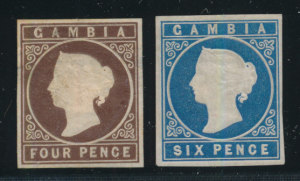The fear of the counterfeiting of postage stamps made for a large number of Nineteenth Century printers' trade offs. The gold standard of anti-counterfeiting technology was line engraved (called intaglio) printing, which, for a special anti-forgery bonus, usually included lathe work. This type of printing rose off the paper and produced a fineness of design that didn't make counterfeiting impossible but made it more difficult and raised the cost (both in time and expertise) to the forgers considerably. Producing line engraved stamps is similar to putting a burglar alarm sign on your front lawn or using the Club in your car. Raising the cost and risk to forgers or thieves means they look elsewhere to earn their living.
Gambia didn't want to pay the cost for line engraved plates for the small press runs of their first issues. The main cost of line engraved is the hand engraved die which is then used to rock into a plate to make a larger printing plate (usually of a hundred). This is the main cost differential between intaglio printing and other methods. The plate preparation of intaglio printing can be quite substantial, which makes little sense if amortized over small press runs. The actual cost of printing, that is making impressions on stamp paper, is similar for all printing methods. The people who ordered Gambia's first issue tried a two tiered printing system to obtain anti-counterfeiting protection at a modest cost. They had the centers of the Gambian stamps embossed and the frames typographed.
Embossing had been used on the early issues of Portugal and had proven to be a very effective anti-counterfeiting tactic (just look at the small number of Portuguese postal forgeries of the Nineteenth Century compared with the postal forgeries of Spain -whose stamps after 1850 were lithographed and were widely forged to defraud the post office). Embossing also makes stamps difficult to reuse as soaking, cleaning, and regumming makes the centers fall out. The downside of embossing as a printing security measure is that the embossed centers tend to fall apart over time and postal patrons don't really care for them. But the stamps of Gambia saw little use and, apparently, all were satisfied.

